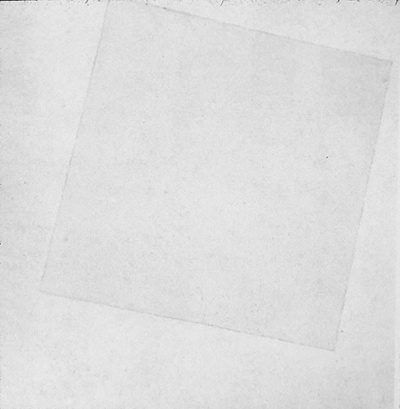The Russian artist, Kazimir Malevich, painted White on White in 1918. This oil on canvas painting measures an impressive, 79.4cm × 79.4cm. Today the painting is housed in the Museum of Modern Art in New York.
Malevich was a Suprematist artist, and White on White is one of his most famous, and reproduced works of art.
White on Write is an abstract work of art that depicts a white square on a white canvas. Malevich painted this a year following the October Russian Revolution. The image was part of the white on white series, that Malevich began to paint in 1916.
White on White depicts the off white square, positioned at a slight angle, that has been placed onto a white background that appears to be warmer and more dense in colour. What Malevich has been able to do is to or present two white squares, in completely different ways. What is uniquely clever is that the second square has not been painted at all, but is simply the square canvas.
At first appearance this piece of art should have no interest or character, due to its lack of colour or depth. We simply observe two white squares. Malevich has rejected all common artistic techniques and principles to create his truly unique piece of art. What we do observe is a clean, geometric and symmetrical painting. It does appear to be most simplistic in its style, but when we observe the painting more closely, this is simply not true. What can be seen are the delicate brushstrokes, telling the observer that colour has been used on canvas. On closer inspection, it is as though the brushstrokes have been applied in such a way as to make the square appear as if it is jumping out of the painting.
It is widely acknowledged that Malevich wanted the squares to appear as if they were floating. This is further heightened by the choice of the white colour which represents tranquility, infinity and timelessness. The painting is not connected to any place, or period in time. What is so very extraordinary, is that the painting is not devoid of personality, which is strange considering that only the white paint medium has been used. There are slight variations in the tones of white that are used. There are also differing applications of the white paint on the canvas. When you quietly observe this painting, what is hard not to feel is a sense of calm and that of healing.
When the paining was unveiled it did cause some controversy within the art world, with many art critics claiming that it was not art. When White on White reached Berlin, during 1927, it was exhibited in the Große Berliner Austellung.
It was then given to Hugo Häring, a famous architect, who then donated it to Alexander Dorner, in 1930, who was the director of the Provinzial Museum in Hanover. It was then sadly pit into storage. When Malevich died in 1935, he had not left any instructions on where he would like the painting displayed or indeed about any details of his estate. It was during this year that the painting was eventually given to the Museum of Modern Art.




